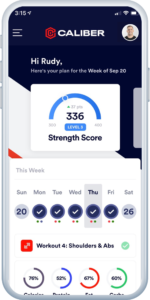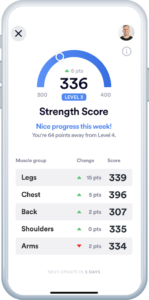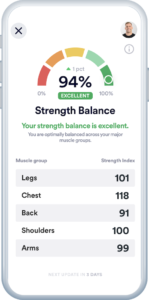Introducing Strength Score

“How do I know if I’m actually making progress?”
If you’re someone that works out, this is a question that you have likely asked yourself from time to time.
You consistently get yourself to the gym, staying on track with your workout routine week after week, but probably sometimes wonder how to connect what you’re doing in the gym to the tangible results that you understandably want from the gym.
If you’re like most people, you might decide to look at the scale for the answer…
And while in some cases your scale weight can be a good indicator of your progress, it doesn’t tell the full story for those of us who are also concerned with improving strength and developing lean muscle, and not simply losing weight.
In fact, more often than not, the scale tends to be a red herring – leading you to falsely believe that things aren’t going well, that you’re doing something wrong, when in reality you are making steady progress towards your goals (often without even realizing it).
Maybe you look towards the mirror as the be-all and end-all measure of where you stand?
Well, even if you’re mainly concerned with visual results, waiting for them to suddenly manifest in the reflection staring back at you can feel like watching paint dry – not to mention the challenge of accurately and unemotionally assessing gradual changes when you look at yourself each day.
Up until now, for people who want to improve their overall body composition – that is, how much body fat you have relative to lean muscle mass – there hasn’t been a single, satisfactory, objective metric to track how you’re actually doing.
So, at Caliber, we decided to create one…
We’re proud to introduce Strength Score: a clear, reliable way to assess your strength training progress, along with improvements to your overall body composition.
The Concept Of Relative Strength
But before we get into Strength Score, let’s take a step back and quickly walk through how this came to be.
At the heart of Strength Score is our belief that the best way to assess your progress in the gym, along with your body composition, is through the little-known concept of relative strength.
Simply put, relative strength is the amount of weight that you are able to lift relative to how much you currently weigh.
The beauty of relative strength is that it is entirely goal agnostic. That is to say, regardless of whether you are primarily focused on losing fat or building strength and muscle, your relative strength should always be improving if everything is going well.
To better illustrate this, let’s imagine that you are currently focused on losing fat. Assuming that things are going well, your weight on the scale will likely be decreasing, while your absolute strength – the maximum amount of weight that you’re able to lift – should hopefully be staying roughly the same (if not improving a bit as well).
In this case, since your absolute strength is staying the same, and your scale weight is decreasing, your relative strength will actually be improving.
Now, let’s take a look at how this might play out when you’re mainly focused on building strength or muscle.
If things are going well, by definition your absolute strength will be increasing, since strength and muscle mass are very highly correlated.
In this case, your weight on the scale might also be increasing slightly (since muscle, of course, weighs something) – but as long as your absolute strength is increasing at a faster rate than your scale weight, your relative strength will also be improving.
Introducing Strength Score
At Caliber, we’ve taken the elegantly simple yet powerful concept of relative strength, and used it to develop a singular metric that our members can use to continuously assess the progress that they’re making.
In the new Caliber app experience, you’ll see your current Strength Score on the dashboard at the top of the screen.

There are 5 different levels to Strength Score:
- Level 100-200 (Beginner)
- Level 200-300 (Intermediate)
- Level 300-400 (Advanced)
- Level 400-500 (Pro)
- Level 500-600 (Elite)
After you complete a full set of workouts, your initial Strength Score will be calculated and displayed for both you and your coach to see.
Then, going forward, your Strength Score will be recalculated each week – factoring in the workouts that you’ve done that week, along with any changes in your scale weight.
Now, it’s important to note that Strength Score is actually a composite score. This means that your overall Strength Score is calculated based on 5 different sub-scores for each of your main muscle group areas.
These are:
- Legs
- Chest
- Back
- Shoulders
- Arms

Each of these are weighted appropriately, based on the body mass that they represent, and come together to form your overall Strength Score.
You’ll be able to see each of these muscle group scores, and how they’re improving over time, by tapping on your Strength Score card at the top of the dashboard.
Most importantly, as your strength score improves, you’ll see this translate into noticeable changes in your body composition over time – as you get leaner, stronger, and more muscular.
With Strength Score, you’ll no longer need to agonize over whether the number on the scale is good or bad, or be subject to the emotional games of the mirror; instead, you can trust that if you’re seeing improvements in your Strength Score, you are necessarily making progress.
How Strength Score Is Calculated
Now that you understand what Strength Score is, you might be wondering how it’s actually calculated.
While a considerable amount of behind-the-scenes math goes into actually calculating your score each week, let’s take a brief look at what happens “under the hood”.
First, we’ll look at your performance for the week across a number of different exercises for each muscle group. To normalize this, and account for different rep ranges, we’ll calculate your estimated 1 rep max for these exercises – the maximum amount of weight that you’re able to lift for a single rep – and use this to determine your absolute strength.
In many cases, each muscle group will actually be broken down into multiple sub-groups. For instance, we’ll calculate your ‘leg’ score by looking at certain exercises to assess your quad strength, and other exercises to assess your hamstring strength, weighting them appropriately for each muscle group.
After that, we’ll apply a multiplier against your absolute strength, based around your scale weight for the week. From this, we’ll figure out which one of the 5 Strength Score levels that you fall into for each muscle group, along with your specific score in each band.
Finally, we’ll aggregate your muscle group scores, weighting each of them based on body mass, until we arrive at your overall Strength Score for the week.
Now, since we want Strength Score to serve as a meaningful indicator of your personal potential, as we’re doing these calculations we’ll also take a number of other factors into account, including your age and gender.
That way, we’ll ensure that your Strength Score is just as relevant if you’re 65 years old as it would be if you were 22 years old.
How We Use Strength Score To Guide Your Progress
While your Strength Score will give you a clear sense of where you stand today, and an objective way to measure the progress that you’re making, it’s also a tool that will help to inform the actual training approach that your coach takes with you.
As we mentioned before, if things are going well, your Strength Score should always be improving, regardless of whether you’re more focused on losing fat, building more strength/muscle, or both.
However, at times, it can be tough to know exactly what you should be focusing on to see the most rapid improvements to your overall body composition, and this is where Strength Score can help.
For instance, if you have quite a bit of body fat to lose, and are newer to strength training, then your coach will develop your training and nutrition plan that allows you to lose fat and build strength and muscle at the same time. As you make progress on both fronts, you should see dramatic improvements to your Strength Score, along with your body composition.
On the other hand, if you’re already quite lean, the most efficient way to improve your Strength Score is not to focus on continued fat loss; rather, you’ll see the most significant improvement to your score by shifting over to focusing on developing your absolute strength instead.
As you continue on your strength training journey with Caliber, your coach will be regularly assessing how your Strength Score is trending, and using it to ensure that you’re making the most efficient progress possible.
Keeping You Evenly Balanced
Alongside Strength Score, we’re introducing another closely-related metric called Strength Balance.
Strength Balance is calculated using the same methodology as Strength Score, but its purpose is to show how well-balanced you are – both from a strength and muscular development standpoint.
You’ll be able to see your Strength Balance on the dashboard of the Caliber app, showing you a breakdown across the 5 different muscle group areas.

Most of us have certain areas that are comparatively weaker than others. For instance, you might have historically focused more on working out your chest, arms, and shoulders, neglecting your back.
Or perhaps you mainly worked out your upper body, without as much of a focus on your lower body.
These imbalances, if left unaddressed, can result in nagging aches and pains, issues with your posture, and may even limit your ability to make further progress in the areas that are comparatively well-developed!
With Strength Balance, you’ll be able to clearly see the areas of your body where you’re the strongest, as well as the areas that could use more work. In turn, your coach will be able to use this data to tailor your training plan appropriately, with the goal of bringing everything into greater balance.
The North Star For Your Strength Training Journey
At Caliber, we’ve long-believed that strength training is truly the most effective way to build muscle, achieve sustainably low levels of body fat, and live a healthier and more purposeful life.
With the introduction of Strength Score, we’re excited to provide our members with a simple, empirical way to chronicle their personal journeys with us, effectively demystifying so much of the uncertainty that many people face when working out.
No longer will you be forced to look at the scale and try to figure out whether it’s actually a bad thing that you’ve gained some weight while diligently following your workout routine.
Or stare anxiously in the mirror each day, wondering if you’re actually making progress.
You’ll finally have a barometer for how you’re doing, along with a clear path to set your goals against and work towards.
And with that level of clarity, we hope that you’ll feel a grounded sense of confidence to resolutely stay the course, continuing to steadily improve in the months and years to come.